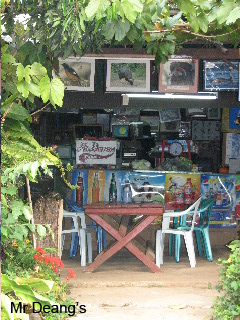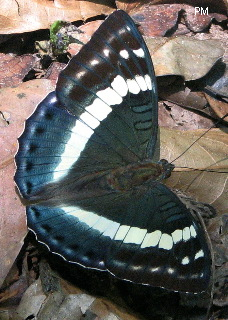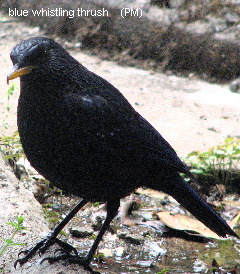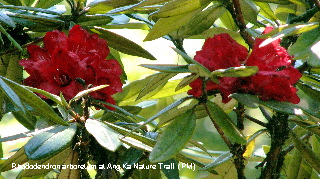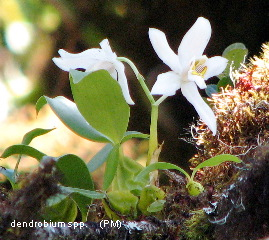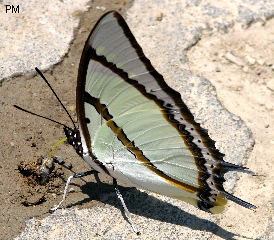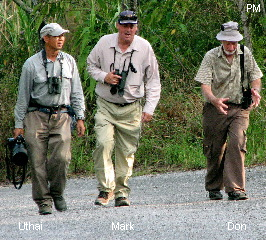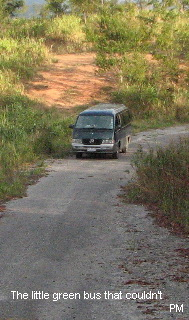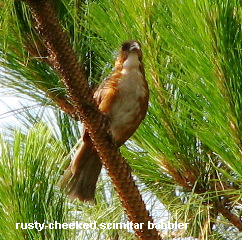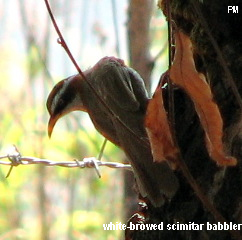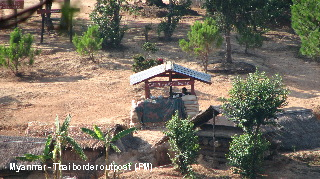
Day ten
Doi Inthanon
Two-thirds up Thailand’s highest mountain, new birds were coming thick and fast. Highlights included grey-throated babbler, rufous-backed sibia, silver-eared mesia, spectacled barwing, Asian emerald cuckoo, yellow-cheeked tit, verditor flycatcher and striated bulbul. The last bird before lunch was the easily overlooked brown-throated treecreeper, no relation but reminiscent of our white-throated treecreeper.
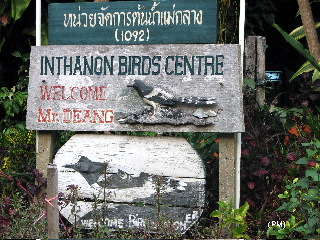
While lolling around after pad Thai at Mr Deang’s famous restaurant, we saw Burmese striped squirrel, soaring oriental honey-buzzards, black-throated sunbird and pied bushchat (no relation to our chats).
Mr Deang’s also houses the Doi Inthanon Birds Centre.
Replenished, we went in search of eye-browed wren-babbler and the slaty-bellied tesia; two skulkers with no tails. The wren-babbler almost walked over our boots and the tesia drew close. The tesia is a tiny bird with a powerful voice box, the call being near deafening at close quarters. Also seen nearby was a white-tailed robin and a brief view was had of speckled piculet.

A visit to Vachiratharn waterfall on the way back to our accommodation produced blue-throated flycatcher, blue-whistling thrush (three or four feeding under the waterfall) and a couple of the dreaded Phylloscopus warblers, the yellow-streaked and yellow-bellied.

Day eleven
Again new birds were flowing freely as we birded close to the summit of Doi Inthanon. Birds went from the sublime, green-tailed sunbirds, to the plain — Phylloscopus warblers, the more obvious at this higher elevation being ashy-throated and orange-barred warblers. Yellow-browed tit got Uthai’s attention, then we had a bay woodpecker and ashy wood-pigeon followed by great views of a lesser shortwing.
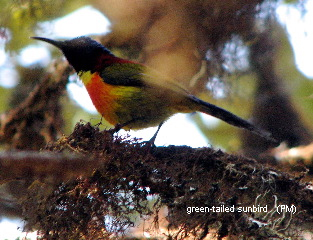
The Doi Inthanon summit’s Ang Ka Nature Trail gets its share of day trippers and birds here are less shy than elsewhere on the mountain. The most common birds seen from the boardwalk were white-browed shortwing and chestnut-winged fulvetta. Uthai got us a good look at an aberrant bush-warbler, a skulker. Chestnut-crowned laughingthrush and the delightful chestnut-tailed minlas are common birds that frequent the gardens around the information centre and tourist shops at the summit.
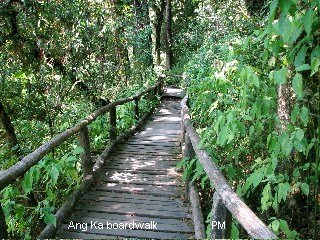
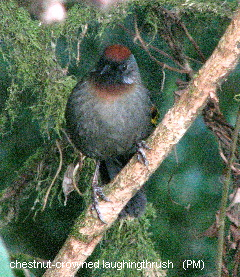
A stop lower down the mountain in pines produced the beautiful velvet-fronted nuthatch and black bulbul. Then back to Mr Deang’s for more noodles.
After lunch we birded around park headquarters, resulting in grey-breasted and hill prinias, great tit, white-browed scimitar-babbler, long-tailed shrike and, for some, brief looks at Siberian rubythroat.Rosemary spotted a small group of white-headed bulbul as we were coming down the mountain later in the afteroon.
Spotlighting that evening gave us oriental scops-owl.
Days twelve
Next morning we birded the dry dipterocarp forest again, well down the mountain, for what proved an excellent raptor day. We saw black baza, crested goshawk, shikra, oriental honey-buzzard, rufous-winged buzzard, grey-faced
buzzard, collared falconet and the pinnacle, the rare white-rumped falcon.
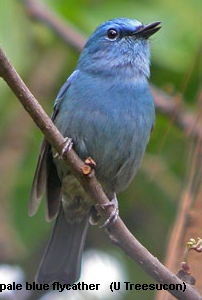
Higher up the mountain in dry pine habitat we had striated yuhina and grey-headed parrotbill. Pale-blue flycatcher was seen further along the road in wetter forest and a few of us had brief views of the skulking Indian cuckoo. We cleaned up on shrike-babblers in one fell swoop. White-browed, black-eared and chestnut fronted shrike-babbler; the latter two about half the size of the white-browed.
Back to our regular table at Mr Deang’s for lunch.
A heavy rainstorm after lunch had Uthai instructing us in the delicate art of using banana leaves as umbrellas. Total saturation would suggest we didn’t pick up on the finer points of the technique. Our enthusiasm was restored with stunning views of two skulkers, white-gorgetted flycatcher and finally, pygmy-wren babbler, which had been eluding us. A small niltava was the icing. We had a great view of black-tailed crake, like a giant version of our spotted crake, at a swampy area near park headquarters
Day thirteen
Before dawn we tried some dry scrubby forest not far from our accommodation for savannah and Indian nightjars and although they were calling fairly close they both managed to evade us. While listening to the dawn chorus, a couple of us caught a glimpse of a fulvous-breasted woodpecker.
Great views were had of a hoopoe feeding young in the roof of a cottage while we were packing to leave Doi Inthanon.
With a long drive in front of us, we headed north of Chiang Mai. The journey was broken by several stops en route. The first was rice fields that gave us green bee-eaters, Indo-Chinese bushlark, oriental skylark and brief views of red-throated pipit, wire-tailed swallow and pin-tailed snipe. We also had our only sighting of the unusual wryneck, a bird that looks somewhat like a cuckoo but is related to woodpeckers.
The monastery and temple at Chiang Dao bestowed Asian paradise flycatcher, ruby-cheeked, purple-naped and crimson sunbirds, streaked wren-babbler, yellow-vented flowerpecker and black-hooded oriole. I suspect our good fortune had more to do with Uthai’s skill than Trisha walking up five hundred or so steps — twice — to offer a deceased Buddhist monk a gardenia flower.
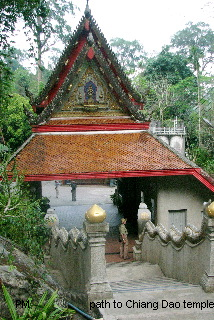
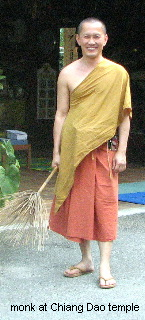
Our little green Mercedes bus struggled to get up Doi Angkhang and had some of us undertaking an arduous uphill hike. I inadvertently lightened the load further by opening the rear door, releasing a few kilos of mangosteens that were last seen rolling towards Chiang Mai.
Day fourteen
A river chat was observed on the roof of Angkhang Nature Resort before breakfast. This bird may have been on migration as it was not seen again. Birding the nearby roadsides after breakfast was rewarding with brown-breasted bulbul, crested finchbill, blue-winged minla, white-browed laughingthrush and the skulking russet bush-warbler.
The Thai people in rural areas are as fascinating as the birds. We focused our binoculars across the valley to a ridge where a procession of hill people were off to work, complete with pack mules and hoes. Uthai reminded us we were there to watch birds, not people!
We went up to an army outpost on the Thai—Myanmar border. Within the no-man’s land between the two borders there were quite a few birds about, including white-browed and rusty-cheeked scimitar-babblers, white-browed laughingthrush, a pair of Burmese shrike building a nest and a stripe-breasted woodpecker. There were some amusing signs in English on the Myanmar side, presumably for the tourists, such as ‘who dares wins’ and ‘while alive never surrender’. Gives you something to ponder.
A bilateral ablutionary accord was evident when we came across a group of Myanmar soldiers bathing on the Thai side of the border. Proceeding further along the border we had blue rock thrush, slender-billed oriole, white-headed bulbul, and one of the great trip birds, spot-breasted parrotbill.
We pulled up at a dense gully on the way back to the resort and Uthai had us a superb pair of red-faced liocichla, a relative of babblers and laughingthrushes, and another highlight of the tour. They were very shy and moving fast but I think everyone got a decent look at them.
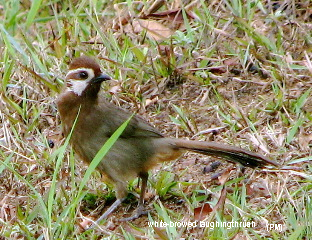
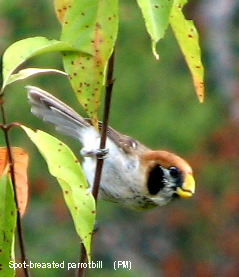
Day fifteen
The next morning we took a trail into the forest and soon scored maroon oriole, Siberian thrush, grey-cheeked fulvetta and got better views of chestnut-fronted shrike babbler.
Back out on the road Uthai heard a green cochoa call and shouted bingo!! Must be a universal word. The purple and the green cochoas are regarded by the locals as THE birds to see in Thailand. They are both quite scarce and will sit still in the rainforest canopy for hours at a time. We approached the calling bird with caution. Trisha saw the bird move and I thought I saw where it landed but soon it was calling further in. Uthai ventured in and spotted it, with me hot on his heels, but the bird flew. I moved to where I thought it landed, and there it was — a male in full view. The troops were right at hand but the bird moved again and could not be relocated. This bird doesn’t look so great in the field guides but it is a heck of a bird in the flesh.
We trekked along a creek in the afternoon. Good birds included white-crowned fork-tail and grey-headed canary flycatcher. We could hear spot-breasted laughingthrush calling but it wasn’t going to be seen.
Day sixteen
As we drove down the mountain the next morning, some white-headed birds flew in front of us. Initially, we thought white-headed bulbul. Uthai rethought — white-headed babbler and we were out like shots. I had written this species off as we had heard but didn’t see them in Kaeng Krachen.
Next up was a visit to what remains of Thaton Marsh, now mostly under cultivation, some of it chilli fields. Good birds here included Baikal bush warbler, thick-billed warbler, cinnamon bittern and little ringed plover.
Later in the afternoon up at Doi Lang on the Thai—Myanmar border, we got a pair of scarce Jerdon’s bushchat carrying food to a nest, the male reminiscent of restless flycatcher; and further up the road we scored stripe-breasted, grey-headed and bay woodpeckers and more spot-breasted parrotbill.
For the second time that afternoon, we ran into some birding friends of Uthais and this time they had their scopes on a lovely pair of mountain bamboo-partridge. A great end to a great day.
Day seventeen
When the next morning we heard Uthai say, “no more piece of cake bird” we knew that 1) there were only hard birds left to get; and 2) he spends too much time with westerners. We were back up along the Thai—Myanmar border and again, there were plenty of birds to be had, including the delightful little pied flycatcher, rufous bellied niltava, yellow-bellied flycatcher, whiskered yuhina, crimson-breasted woodpecker, golden-throated barbet and short-billed minivet. We tried for spotted wren-babbler, a species that Uthai discovered in Thailand only a month before we arrived but no joy.
Uthai’s friends’ twin cab ute was sequestered even before our little green Mercedes bus tackled the steeper hills. Four of us hitched a ride in the ute. Ye of little faith! After lunch, we headed back to Chiang Mai with just one stop to look for blue magpie at an experimental area with some plantation forest. This produced Siamese hare, chestnut-tailed starling and common woodshrike but no magpie.
After dinner at the Thai Cultural Centre, Uthai let us loose at the famous Chiang Mai night bazaar for an hour.

Day eighteen
At a dam at a government research area north of Chiang Mai the next morning we saw a male green peacock, in all his splendour, come down to drink. Here also was quite a large flock of lesser whistling duck. Ducks generally are scarce in Thailand and we saw only two species for the whole tour. I scored a Javan mongoose but it disappeared before too many others saw it.
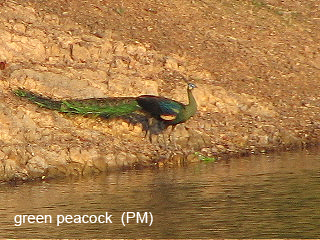
Some of the birds at a swampy gravel pit back near Chiang Mai were ruddy-breasted crake, cinnamon bittern, yellow-bellied and plain prinias. Siberian rubythroat was calling but was not to be seen.
Doi Suthep on the northwest side of Chiang Mai gave us our final birds for the tour. These included brown-cheeked fulvetta and at last, the silver-breasted broadbill. We got good views of striated and white-bellied yuhinas, grey-throated and buff-breasted babblers and the cute speckled piculet.
We flew back to Bangkok in the mid afternoon and called it a tour.
part i
checklist of species seen on 2007 tour
mammal list reptiles list
2008 Thailand itinerary
possible birdlist 2008
